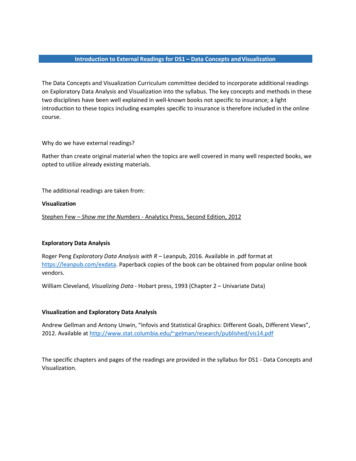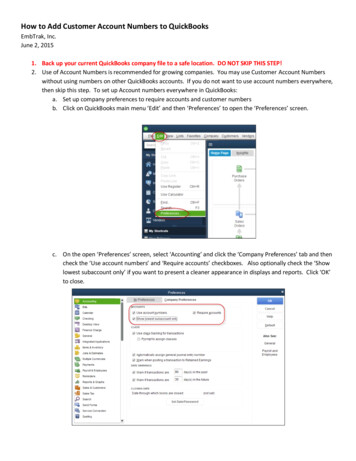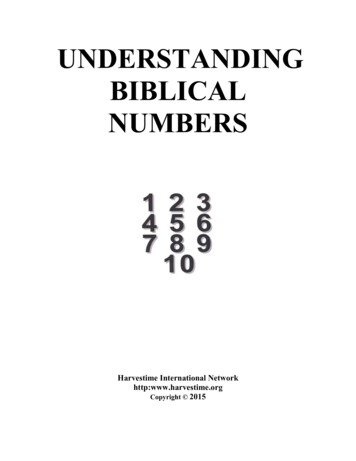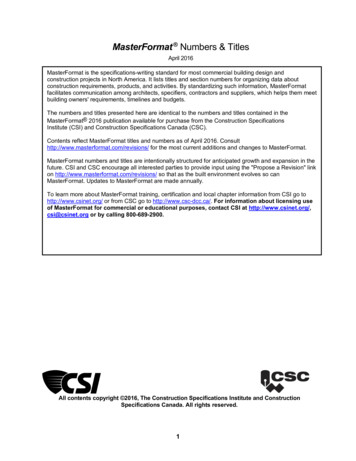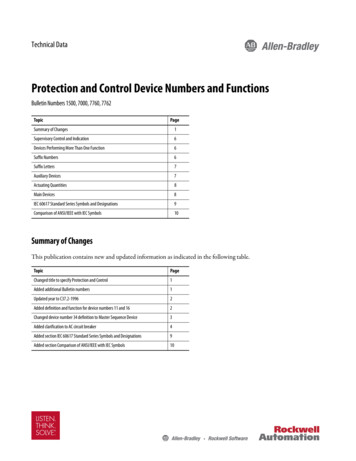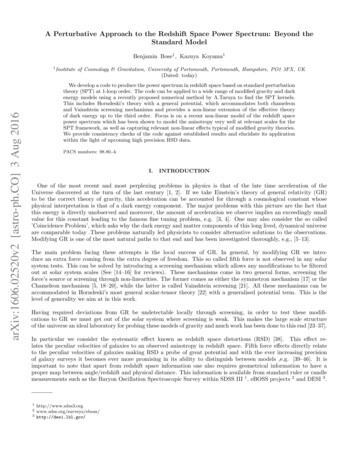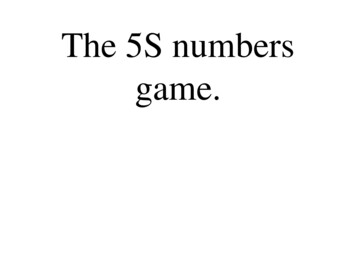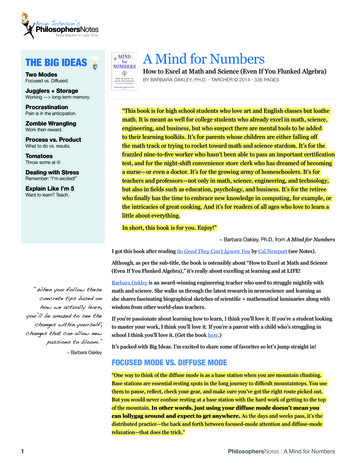
Transcription
Brian Johnson’sPhilosophersNotesTMMore Wisdom in Less TimeTHE BIG IDEASTwo ModesFocused vs. Diffused.A Mind for NumbersHow to Excel at Math and Science (Even If You Flunked Algebra)BY BARBARA OAKLEY, PH.D. · TARCHER 2014 · 336 PAGESJugglers StorageWorking — long-term memory.ProcrastinationPain is in the anticipation.Zombie WranglingWork then reward.Process vs. ProductWhat to do vs. results.TomatoesThrow some at it!Dealing with StressRemember: “I’m excited!”Explain Like I’m 5Want to learn? Teach.“This book is for high school students who love art and English classes but loathemath. It is meant as well for college students who already excel in math, science,engineering, and business, but who suspect there are mental tools to be addedto their learning toolkits. It’s for parents whose children are either falling offthe math track or trying to rocket toward math and science stardom. It’s for thefrazzled nine-to-five worker who hasn’t been able to pass an important certificationtest, and for the night-shift convenience store clerk who has dreamed of becominga nurse—or even a doctor. It’s for the growing army of homeschoolers. It’s forteachers and professors—not only in math, science, engineering, and technology,but also in fields such as education, psychology, and business. It’s for the retireewho finally has the time to embrace new knowledge in computing, for example, orthe intricacies of great cooking. And it’s for readers of all ages who love to learn alittle about everything.In short, this book is for you. Enjoy!” Barbara Oakley, Ph.D. from A Mind for NumbersI got this book after reading So Good They Can’t Ignore You by Cal Newport (see Notes).Although, as per the sub-title, the book is ostensibly about “How to Excel at Math and Science(Even If You Flunked Algebra),” it’s really about excelling at learning and at LIFE!Barbara Oakley is an award-winning engineering teacher who used to struggle mightily with“When you follow thesemath and science. She walks us through the latest research in neuroscience and learning asconcrete tips based onshe shares fascinating biographical sketches of scientific mathematical luminaries along withhow we actually learn,wisdom from other world-class teachers.you’ll be amazed to see thechanges within yourself,changes that can allow newpassions to bloom.” Barbara OakleyIf you’re passionate about learning how to learn, I think you’ll love it. If you’re a student lookingto master your work, I think you’ll love it. If you’re a parent with a child who’s struggling inschool I think you’ll love it. (Get the book here.)It’s packed with Big Ideas. I’m excited to share some of favorites so let’s jump straight in!FOCUSED MODE VS. DIFFUSE MODE“One way to think of the diffuse mode is as a base station when you are mountain climbing.Base stations are essential resting spots in the long journey to difficult mountaintops. You usethem to pause, reflect, check your gear, and make sure you’ve got the right route picked out.But you would never confuse resting at a base station with the hard work of getting to the topof the mountain. In other words, just using your diffuse mode doesn’t mean youcan lollygag around and expect to get anywhere. As the days and weeks pass, it’s thedistributed practice—the back and forth between focused-mode attention and diffuse-moderelaxation—that does the trick.”1PhilosophersNotes A Mind for Numbers
Focused mode vs. diffuse mode. We need ‘em both.“Research has shown thishelps your subconsciousto grapple with the taskson the list so you figureout how to accomplishthem. Writing the [task]list before you go to sleepenlists your zombies to helpyou accomplish the itemson the list the next day.” Barbara OakleyHerbert Benson wrote a whole book on this called The Breakout Principle (see Notes). And,Jim Loehr describes something similar as “training our recovery.” He tells us we need to “makewaves” between intense effort and equally intense recovery.Focused mode is pretty straight-forward: Put in the effort! Think: The hard work of mountainclimbing.Diffused mode includes things like workout out, going for a hike, taking a nap, getting amassage, meditating, taking a bath/shower and the ultimate diffuse mode: SLEEPING! Think:The basecamps where we recover.Magical things happen when we turn our conscious minds off and let our subconscious mindsgo to work. As Heidi Grant Halvorson tells us in Succeed (see Notes), “Metaphorically speaking,if your unconscious mind can hold information equivalent to a NASA supercomputer, yourconscious mind can hold roughly the contents of a Post-it note.” — We want to put thatsupercomputer to work.How’s your focus? And how’s your diffusing?What are you doing well in each and how can you dial each in?!THE JUGGLER & THE STORAGE FACILITY“Working memory is the part of memory that has to do with what you areimmediately and consciously processing in your mind. It used to be thought that ourworking memory could hold around seven items, or ‘chunks’ but it’s now widely believed thatthe working memory holds only about four chunks of information. You can think of workingmemory as the mental equivalent of a juggler. The four items stay in the air—or in workingmemory—because you keep adding a little energy.In contrast, long-term memory might be thought of as a storage warehouse. Onceitems are in there, they generally stay put. The warehouse is large, with room for billions ofitems, and it can be easy for stored parcels to get buried so deeply that it’s difficult to retrievethem. Research has shown that when your brain first puts an item of information in long-termmemory, you need to revisit it a few times to increase the chances you’ll later be able to find itwhen you need it.”I love this.Our memory has two primary components: working memory and long-term memory.Think of working memory as a juggler keeping the stuff you’re “working on” understanding in“It’s important totransform distant deadlinesinto daily ones. Attack thembit by bit. Big tasks need tobe translated into smallerones that show up on yourdaily task list. The onlyway to walk a journey of athousand miles is to takeone step at a time.” Barbara Oakleythe air. As we more and more deeply understand the content we’re working on, the juggler tossesthe balls/memory ”chunks” into a big ol’ storage warehouse that is our long-term memory.Then we need to keep the warehouse nice and organized by coming back to the information afew times after learning it—which is called “spaced repetition.”I read this book excited about finding Ideas to help me optimize both my learning AND myteaching. I was particularly moved by this Idea of simplifying, chunking and spacing repetitionsso we can lock these Big Ideas firmly in our minds and lives as this is precisely what I aspire todo with these Notes Micro Classes.A couple other quick tips on improving your learning: Use recall: After reading a Note orwatching a Micro Class, look away and recall the essence of the Idea (and think about howyou can apply it!). Be excited to revisit an Idea from a different angle knowing that the spacedrepetition is helping you program the wisdom (juggler — warehouse).2PhilosophersNotes A Mind for Numbers
“Deficiencies of innateability may be compensatedfor through persistent hardwork and concentration.One might say that worksubstitutes for talent, orbetter yet that it createstalent.” Santiago Ramon y CajalPROCRASTINATION: THE PAIN IS IN THE ANTICIPATION“We procrastinate about things that make us feel uncomfortable. Medical imagingstudies have shown that mathphobes, for example, appear to avoid math because even justthinking about it seems to hurt. The pain centers of their brains light up when they contemplateworking on math.But there’s something important to note. It was the anticipation that was painful. When themathphobes actually did math, the pain disappeared. Procrastination expert Rita Emmettexplains: ‘The dread of doing a task uses up more time and energy than doing the task itself.’Avoiding something painful seems sensible. But sadly, the long-term effects of habitualavoidance can be nasty. Procrastination is a single, monumentally important‘keystone’ bad habit. A habit, in other words, that influences many important areas of yourlife. Change it, and a myriad of other positive changes will gradually begin to unfold.”You ever procrastinate? (If you’re human (or even superhuman) odds are you do on something!)Get this: Your brain lights up with pain when you simply think about whatever it is you prefer toavoid. AND. That pain in your brain goes away when you actually do it. (How awesome is that?)Remember: Procrastination is like an addiction. It gives a temporary hit of feeling good but hasdevastating long-term consequences.Barbara dedicates several chapters to understanding and dealing with procrastination. Shereferences a couple books we have Notes on to help us create better habits. Check out our Noteson The Power of Habit by Charles Duhigg and The Now Habit by Neil Fiore for more goodness.For now, know that you CAN change your procrastination habit and that it’s wise to invest theenergy into knocking out that keystone destructive habit. Practice disciplining yourself to reducedistractions and take the actions you’ve deemed important.Every time you take a step forward you’re building muscle. Let’s do the lifting and let’s look atsome more Ideas on how to rock it!ZOMBIE WRANGLING“Do you like to check your e-mail or Facebook right when you wake up in the morning? Set atimer for ten minutes of work first thing instead—then reward yourself with online time. Youwill be surprised to see that this tiny exercise in self-control will help empower you over yourzombies through the day.Warning: When you first sit down to try this, some of your zombies will scream as if they wantto eat your brain. Tune them out! Part of the point of this exercise is learning to laugh at yourzombies’ antics as they predictably tell you, ‘Just this once it’s okay to check Facebook rightnow.’”Your zombies want to eat your brain. Don’t let them!!! :)“Multitasking is likeconstantly pulling up aplant. This kind of constantshifting of your attentionmeans that new ideas andconcepts have no chance totake root and flourish.” Barbara OakleyDo you wake up and hit your email/Facebook/whatever first thing? Let’s build a better AMroutine, shall we?! Remember: Your AM and PM “bookends” to your day are the times you havethe most control. Let’s make them masterpieces!Installing my own AM (and PM!) rituals has easily been one of the biggest things I’ve done formy productivity, happiness and sense of purpose-driven flourishing.As per my masterpiece day video, I wake up nice and early sans alarm (thanks PM rituals!), takecare of biological business and meditate. 20 minutes. Every morning. Then it’s 5 minutes ofstretching then it’s my most important creative work—either creating a PDF or reading.PhilosophersNotes A Mind for Numbers3
After crushing that I’m GIDDY to reward myself with an online hit. YouTube comments,member chats, email, etc. It’s hard to have a bad day when you start like that.“The essential point here isthat the zombie, habitualpart of your brain *likes*processes, because it canmarch mindlessly along. It’sfar easier to enlist a friendlyzombie habit to help with aprocess than to help with aproduct.” Barbara OakleyI *used* to wake up late (thanks poor PM rituals!), reach over and grab my iPhone andimmediately hopped into email. Post that jolt, it was *really* hard to quiet my mind so I could dosome really solid creative work.Now that I know what it feels like to have a super clear, creative mind, it’s hard to believe how Iused to do things. I will never go back to the old ways. Ever.How about you? Any room for optimizing here? Let’s wrangle the zombies and rock it!FOCUS ON PROCESS NOT PRODUCT“If you find yourself avoiding certain tasks because they make you uncomfortable, there is agreat way to reframe things: Learn to focus on process, not product.Process means the flow of time and the habits and actions associated with that flow of time—as in, ‘I’m going to spend twenty minutes working.’ Product is an outcome—for example, ahomework assignment that you need to finish.To prevent procrastination, you want to avoid concentrating on product. Instead, your attentionshould be on building processes—habits—that coincidentally allow you to do the unpleasanttasks that need to be done.”Process vs. Product.We come back to this again and again and that’s a REALLY good description of a processorientation vis-a-vis an outcome/product orientation. Check in the next time you find yourselfprocrastinating and see if you’re focusing on the OUTCOME or PRODUCT of your effort ratherthan simply putting in the effort.Personally, I can think about finishing a Note and then put it off because I don’t think I haveenough time and/or (gasp!) I don’t feel like doing it. — Product/Result/Outcome focus.Or, I can think about simply putting in xx minutes and leave it at that. — Process focus.That’s actually what I just did with this Note. I had a little extra time this afternoon and thoughtI’d just put in 20-30 minutes of good work. The time just flew and now I’m nearing completion.“Focus on the process(the way you spend yourtime) instead of theproduct (what you want toProcess! I wouldn’t have even started if I thought I had to finish (product!).Note: After almost going online to go buy a book Barbara referenced, I turned the Wi-Fi off—which came in handy a few minutes later when I conjured up another good reason to go online.I laughed as I got the “you’re offline” error message. Thank you, past self for pre-committing theaccomplish).”future version of us to a virtuous path! Barbara OakleyHow about you? How can you shift from product to focus a little more on process in your life?THROW A TOMATO AT IT!“The ‘Pomodoro’ is a technique that’s been developed to help you focus your attention overa short period of time. Pomodoro is Italian for ‘tomato’—Francesco Cirillo, who originallydeveloped this time-management system in the 1980s, used a tomato-shaped timer. In thePomodoro technique, you set a timer for twenty-five minutes. Once the timer starts ticking,you’re on the clock. No sneaking off to web surf, chat on the phone, or instant message yourbuddies. What’s nice about doing a Pomodoro is that if you’re working around friends or family,you can tell them about the technique. Then, if they happen to interrupt you, all you need todo is mention that you’re ‘doing a Pomodoro’ or ‘on the clock,’ and it gives a friendly reason forthem to leave you alone.”4PhilosophersNotes A Mind for Numbers
Pomodoro!This is a genius time-management hack I first heard about from one of the guys on our en*theosteam. (Go John!!!) When we’d strategize about next steps on a project, he’d end our chat with,“I’ll go throw a tomato (or 5) at it!” Smiling as I type that. So good.What do you need to throw a tomato (or 3) at?DEALING WITH STRESS!“In learning, persistence is“If you’re a stressed-out test taker, keep in mind that the body puts out chemicals, such asoften far more importantcortisol, when it is under stress. This can cause sweaty palms, a racing heart, and a knot inthan intelligence.” Barbara Oakleythe pit of your stomach. But interestingly, research finds that it’s how you interpret thosesymptoms—the story you tell yourself about why you are stressed—that makes the difference. Ifyou shift your thinking from ‘this test has made me afraid’ to ‘this test has got me excited to domy best!’ it can make a significant improvement in your performance.Another good tip for panicky test takers is to momentarily turn your attention toyour breathing. Relax your stomach, place your hand on it, and slowly draw a deep breath.Your hand should move out, even as your whole chest is moving outward like an expandingbarrel.By doing this type of deep breathing, you are sending oxygen to critical areas of your brain. Thissignals that all is well and helps you calm down. But don’t just start this breathing on the day ofthe test. If you have practiced this breathing technique in the weeks before—just a minute or twohere and there is all it takes—you will slide more easily into the breathing pattern during the test.(Remember, practice makes permanent!)”This is from a chapter on test taking. Tons of goodness in there we can apply to any and allstressful times in our lives—tests and otherwise!First, in our Notes on Kelly McGonigal’s The Upside of Stress we talked about the fact that it’s allabout how we INTERPRET the stress response that determines how it affects us.When you feel the nerves and your heart starts racing while your palms get a little sweaty youhave a choice.You can say: “Oh, man! I’m super scared. I hope I don’t choke. I better try to calm down!!”Or.Much more effectively, you can say: “Oh, wow! There it goes. My body is getting ready to crushit. I’m excited!! LET’S DO THIS!!”Which one do you think will have a more positive impact on your performance? Research isclear. Let’s get excited. :)That’s part one. Next up: BREATHE!!A simple, nice, deep, relaxing breath resets our nervous system and puts oxygen right where weneed it. Inhale to 6. Hold for 2. Exhale to 7. That’s my new favorite count. Repeat with a smile.And, remember: We can’t expect the breathing to work if we only do it the moment we needit. We need to practice!! A minute or two (or ten or fifteen!) here and there and we’ve built theengine to get the optimal benefit.These days I start every single meditation with 5 of those 6-2-7 breaths, when I lay down for anapitation it’s 6-2-7 and when I lay down to go to sleep it’s 6-2-7.Practice makes permanent!( — Love that phrase — Barbara comes back to it many times throughout the book!)PhilosophersNotes A Mind for Numbers5
EXPLAIN LIKE I’M 5“Reshaping your brain is“The legendary Charles Darwin would do much the same thing. When trying to explain aunder your control. Theconcept, he imagined someone had just walked into his study. He would put his pen down andkey is patient persistence—try to explain the idea in the simplest terms. That helped him figure out how he would describeworking knowledgeably withthe concept in print. Along those lines, the website Reddit.com has a section called ‘Explain likeyour brain’s strengths andI’m 5’ where anyone can make a post asking for a simple explanation of a complex topic.weaknesses.”You may think you really have to understand something in order to explain it. But observe what Barbara Oakleyhappens when you are talking to other people about what you are studying. You’ll be surprisedto see how often understanding arises as a consequence of attempts to explain to others andyourself, rather than the explanation arising out of your previous understanding. This is whyteachers often say that the first time they ever really understood the material was when they hadto teach it.”Want to *really* learn something? TEACH IT! :)I love the distinction Barbara makes here. Often our understanding is a *consequence* ofexplaining something.Alexandra and I are always sharing stories about what we’re learning. It’s one of the best ways toreally drive an idea home.And, it’s one of the reasons I LOVE teaching so much and in so many different formats—byforcing myself to explain things in the simplest way possible I help drive the wisdom deeper anddeeper into my consciousness.How can you start sharing your favorite Ideas with people in your life?! Let’s have fun studying,teaching and embodying as we optimize and actualize!Brian Johnson,Chief PhilosopherIf you liked this Note,you’ll probably like So Good They Can’tIgnore YouThe Power of HabitThe Now HabitMindsetThe Talent CodeThe Upside of StressAbout the Author of “A Mind for Numbers”BARBARA OAKLEY, PH.D.Barbara Oakley is a professor of engineering at Oakland University in Rochester,Michigan. Her research has been termed “revolutionary” by the Wall StreetJournal. She has received many national awards for her teaching, includingthe American Society of Engineering Education Chester F. Carlson Award foroutstanding technical innovation in STEM pedagogy and the Theo L. PilkingtonAward for exemplary work in bioengineering education. Connect: barbaraoakley.com.About the Author of This NoteBRIAN JOHNSONBrian Johnson loves helping people optimize their lives as he studies, embodiesand teaches the fundamentals of optimal living—integrating ancient wisdom modern science common sense virtue mastery fun. Learn more andoptimize your life at brianjohnson.me.6PhilosophersNotes A Mind for Numbers
stretching then it’s my most important creative work—either creating a PDF or reading. PhilosophersNotes A Mind for Numbers 3 “Multitasking is like constantly pulling up a plant. This kind of constant shifting of your attention means that new ideas and concepts have no chance to take root and flourish.” Barbara Oakley
